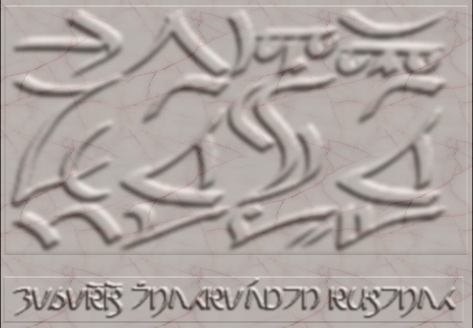The Ákat alphabetical scripts
Ákat routinely employs a number of scripts and writing systems. In all systems, the writing proceeds from left to right, moving down the page in lines. This page provides details on the Common script and the Monumental script as employed by the Ákat language (both scripts are also used, with some variations, for other Telik and Nakap lineage languages).

A more recent development has been that of the logographic script. This innovative script first appeared around four centuries ago. It was developed with a specific purpose of reflecting the philosophical roots of the language more clearly within its written form. A simplified form of this system has become popular for poetry and art, as well as for more philosophical writing.
The Ákat common script
The common script - aptly named as it is the most commonly used writing system - is a much simplified version of the script used to write various Telik languages some ten centuries ago. Most written documents - letters, newspapers, novels, etc - use the common script.
Vowels:
 |
i |  |
í or wi |  |
ì or ji |  |
î or hi | |
 |
e |  |
é or we |  |
è or je |  |
ê or he | |
 |
a |  |
á or wa |  |
à or ja |  |
â or ha | |
 |
y |  |
ý or wy |  |
ỳ or jy |  |
ŷ or hy | |
 |
o |  |
ó or wo |  |
ò or jo |  |
ô or ho | |
 |
u |  |
ú or wu |  |
ù or ju |  |
û or hu |
Consonantal stops:
 |
p |  |
t |  |
k |  |
q | |
 |
b |  |
d |  |
g |  |
hq |
Consonantal fricatives:
 |
f |  |
s |  |
x |  |
c | |
 |
v |  |
z |  |
hx |  |
hc |
Other consonants:
 |
m, hm |  |
n |  |
hn |  |
hr | |
 |
r |  |
l |  |
' or ! (glottal stop) |
Common ligatures
It is common practice, when two adjoining letters end and start in a vertical stroke, for those strokes to be merged - effectively forming a single glyph for separate letters. The vowels 'y', 'o', and 'u' are particularly prone to merging with the following letters: p/b, t/d, k/g, f/v, s/z, l and u.
- 'y-' ligature series

- 'yu-' ligature series

- 'o-' ligature series

- 'ou-' ligature series

- 'u-' ligature series

- 'uu-' ligature series

Example




The Ákat monumental script
The common script is itself a descendant of a much older writing system known as the monumental script. Again, a simplified version of the monumental script is today used for newspaper headlines and, as the name suggests, monumental inscriptions.
The monumental script differs from the common script in that the entire vowel is placed above the preceding consonant. Where no consonant precedes the vowel, a special vowel carrier sign is employed. Vowels are necessarily smaller than consonants, with the stress signs combined within each base vowel (making 24 distinct surletters) - this inevitably means that the script needs to be large if it is to be legible.
Vowels:
 |
i |  |
í or wi |  |
ì or ji |  |
î or hi | |
 |
e |  |
é or we |  |
è or je |  |
ê or he | |
 |
a |  |
á or wa |  |
à or ja |  |
â or ha | |
 |
y |  |
ý or wy |  |
ỳ or jy |  |
ŷ or hy | |
 |
o |  |
ó or wo |  |
ò or jo |  |
ô or ho | |
 |
u |  |
ú or wu |  |
ù or ju |  |
û or hu |
Consonantal stops:
 |
p |  |
t |  |
k |  |
q | |
 |
b |  |
d |  |
g |  |
hq |
Consonantal fricatives:
 |
f |  |
s |  |
x |  |
c | |
 |
v |  |
z |  |
hx |  |
hc |
Other consonants:
 |
m, hm |  |
n |  |
hn |  |
hr | |
 |
r |  |
l |  |
' or ! (glottal stop) |